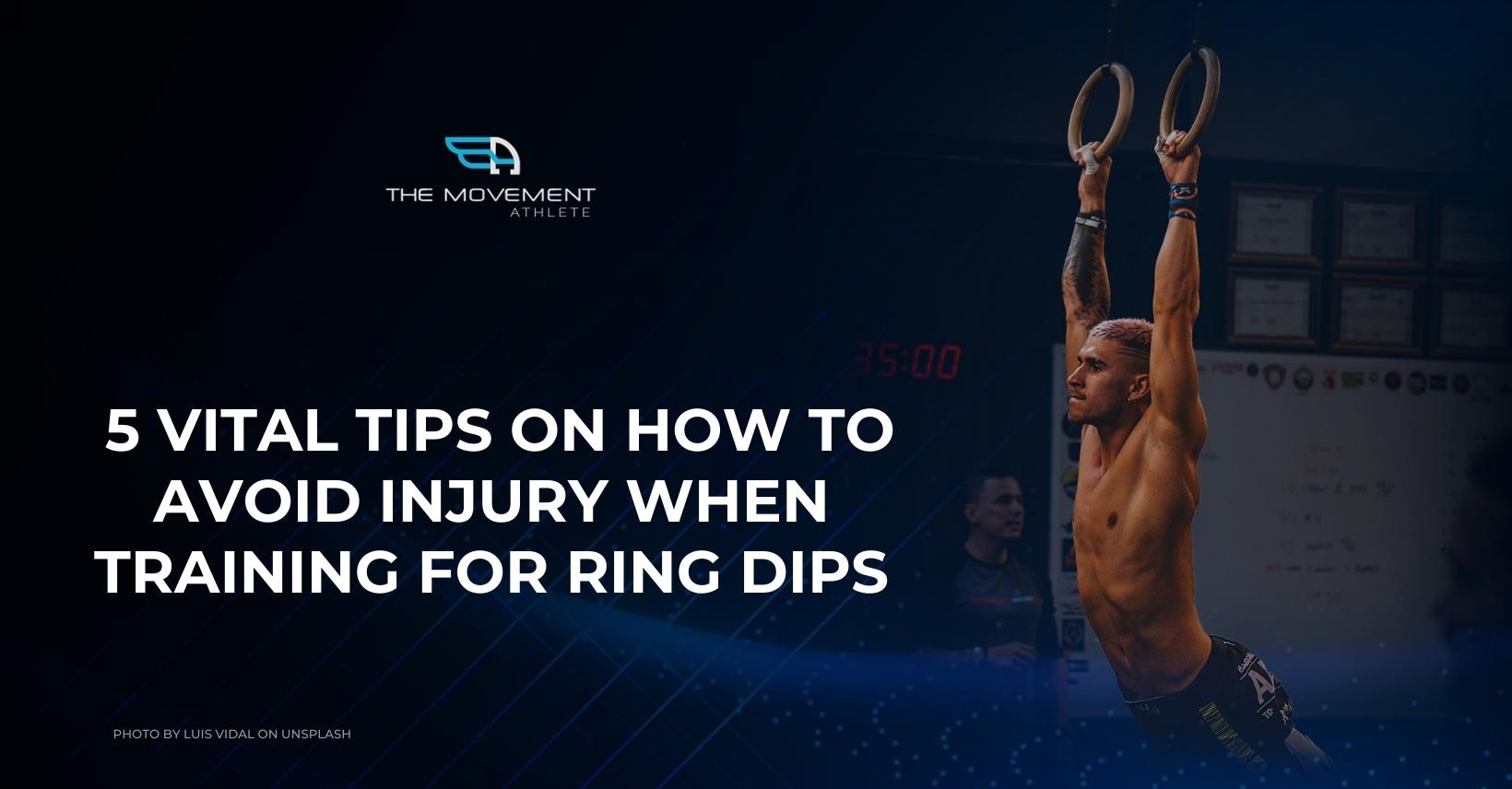
Join the tribe of Movement & Calisthenics Athletes – people just like you that are working with their own body weight to get strength, lose fat build muscle, recover from injuries and live their best lives!
Here’s the truth about training injuries!
🤜The truth is, whatever movement you do, there will always be a risk of injury. The more we move, the more we get active, the higher the risk, especially if we’re moving towards more intermediate exercises such as the ring dips.
Relatively, it’s a low-risk exercise, but a possibility to hurt yourself with the exercise still exists if you don’t follow these five tips.
Avoid injury🤕 so you can keep on making progress and save a lot of frustration and effort blaming yourself after not safely knowing by heart these tips we’ll give you.
Specific warm-up
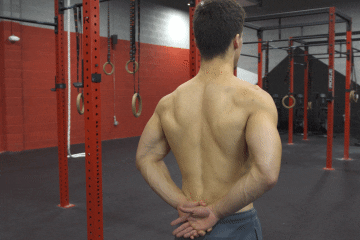
Scapula retraction and depression exercises are perfect for pre-activating your shoulder blades in the position for ring dips: better performance and lower risk of injury.
👊Ring dips are an intense exercise. You’ll need to control your full bodyweight on an unstable surface, so you need your muscles, joints, and mind prepared to take on this challenging exercise.
As the word suggests, proper warm-up warms the blood, passive structures, and muscles to perform when executing the exercises optimally. It will enhance your output which means better gains; it also minimizes sudden force applied to your body if you don’t warm up properly.
👆Of course, warm-ups aren’t all the same. Running 3km for ring dips won’t prepare you for this strength-developing exercise. What you need is a warm-up routine specific to the upper body. This means it should include movements for your wrists, shoulder joints, chest muscles, triceps, and core.
You can also employ light upper-body mobility exercises before you start your workout. Warm-ups shouldn’t be tiring and burn too much of your energy, but it should be enough to make you sweat so you get your blood going to the right muscle groups you’re going to target in your primary workout.
For a complete guide on what, why, and how to warm up, check out the article below:
📍 The Ultimate Calisthenics Warm-up Guide
Meeting the requirements

Mastering dips on a stable surface is crucial if you want to safely enter the ring dips realm.
Heading straight to ring dips without knowing the prerequisites sets you up for disaster! Like any other skill, you need to meet a certain level of requirements to handle the load of the ring dip safely.
👍The phrase “doing too much, too soon” applies here. If you don’t meet the strength, mobility, and skill requirements, you’ll apply too many demands on your body which it can’t handle yet. And that’s the biggest factor why people get injured.
The solution?
It’s simple. Know the exercise prerequisites so you can make progress safely and efficiently. For an in-depth discussion on the ring dip prerequisites, check out the article below:
📍 MUSCLES USED AND REQUIREMENTS
Here are other drills and exercises you can work with so you can approach ring dips more safely.
📍 RING DIP ADDITIONAL EXERCISES
In order to learn ring dips, you need to train the skill itself, but that doesn’t mean you’ll neglect other exercises all throughout the learning process.
The exercises above will help you address weak links that might prevent you from learning ring dips. Strengthening these weak links will drastically reduce the risk of injury.
Take it slowly on your joints!
Take special attention to your elbow and shoulder joints. To stabilize yourself on the rings, ring dips require full elbow-lockout and shoulder stability. Unfortunately, these passive structures don’t regenerate and grow as fast as our muscles. So when you’re joints aren’t prepared to handle the load, that’s when injuries can occur.
💥Using the right progression
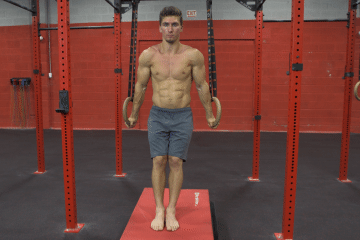
Rushing with the progressions might lead to injury if your body isn’t prepared.
When unlocking ring dips, you don’t jump right into the exercises even if you already meet the necessary foundation.
Even if you already have 10 to 20 dips on a stable surface, the jump to the ring dip is huge. It would feel like a new exercise, and it’s guaranteed that you’ll be violently shaking when attempting to hold the support hold position.
The workaround is to train the right progression that suits your current skill level. Check out the complete progression list for ring dips in the article below:
Don’t underestimate the power of progressions. Like the previous tip, if you’re doing too much, too soon, your body will inevitably fail, and you could hurt yourself when performing the ring dips.
Avoiding mistakes
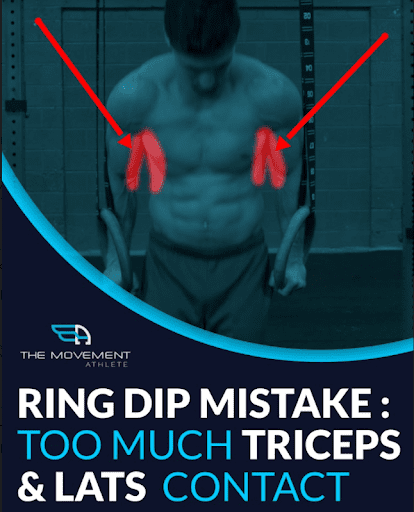
The mistake above can make your forearm lean too much on the straps for additional but unwanted assistance. Plus it will hurt like hell.
When first learning ring dips (or if you have already done this for months), you could be susceptible to making rip dip technique mistakes.
Not only you won’t be efficient with your gains, making some mistakes can increase the risk of injury by tenfold, especially on the shoulder joint and the chest muscles.
It’s easy to tear your pec muscles when moving too fast on the ring dips since you don’t have complete control of the stability and of the movement.
The shoulders are also prone to impingement or tears if it’s not stabilized correctly from the starting support hold and throughout the motion.
Here’s a quick round of mistakes which you can check out the full explanation in the link below:
📍 MISTAKES TO AVOID
- Bent arm support hold
- Shrugged shoulders and head jutted forward
- Resting on straps
- Not dipping low enough
- Moving too fast
- Lat and tricep contact
- Not finishing the lockout
Following proper form
Proper form is vital for efficient and safe progress, whether you’re doing ring dips, regular dips on the stable surface, pull-ups, or other exercises.
Incorrect form can put unnecessary strain on your body, especially if your body isn’t capable of handling further loading.
📌Here are incorrect positions and techniques and what potential damage they can lead to:
- 🤕Head jotted forward – If you’re not pushing your shoulders down and elongating your spine into a neutral position, unnecessary loading can build on your neck, which can lead to neck strains and damage your posture.
- 🤕Triceps and lats contact and lack of turn out – If your triceps have too much contact with your lats and your lack proper ring turn out at the top, it can lead to your forearms rubbing too much on the straps. While it seems like a minor inconvenience, trust me, it will hurt and impede your ability to do more reps the next session or even after the set!
- 🤕Elbows flaring out – Having your elbows move outside the scapular plane (elbows move in front of your shoulders) can lead to shoulder impingement.
- 🤕Shrugged shoulders – This position adds tension to your joints instead of putting stress on your shoulder muscles. A proper depressed shoulder position keeps you stabilized as well too!
Here’s a complete guide on performing ring dips with good technique.
Keep in mind that the risk of form breakdown gets higher as fatigue sets in. However, this doesn’t necessarily mean that the risk of injury gets higher already. Form breakdown is inevitable, just like fatigue, so the best way to move forward is to train near fatigue but not total muscular failure. If you’re nearing exhaustion and no longer perform ring dips with good form, you can always move to an easier exercise progression.
Bodyweight fundamental mastery
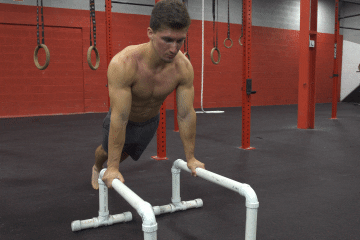
Coach Jeremy showing how basic push-ups can be altered for specific ring dip gains.
Like any other intermediate to advanced exercise, you got to start with the basics first. Calisthenics fundamentals set the foundation for a safe journey towards mastering the ring dips.
It’s a cliche, but you need to learn how to walk first before running. The same thing goes for calisthenics skills. You need to know how to do push-ups and dips on a stable surface before attempting more challenging variations such as on the rings.
Here’s another comparison, 🧐 a building without a strong foundation will crumble. The same thing goes with our bodies. If we don’t prepare ourselves enough through proper fundamental training, our bodies will not handle the force of the ring dips and lead to injuries.
📌Mastering the following:
-
- Dips on a stable surface – A given requirement to learn ring dips for acquiring basic movement pattern, mobility, and strength
- Push-ups – Assist in pushing strength development
- Pull-ups – Balances pulling muscle strength
- Bodyweight squats – Balances lower body development
- Handstand on the wall – An essential calisthenics move for better body control and awareness in space
- Basic core strength – Covering global core development back, side, front, and proper positioning
- Abs
- Obliques
- Back
- Bodyline
In summary
Ring dip isn’t a high-impact or dangerous move. As mentioned before, every movement has some risk. The intermediate level, such as ring dips, sets a higher risk than dips on a stable surface, but the risk isn’t that high.
However, it’s still best to take actions to minimize the risk so you can focus more on your progress and get less stress on your ring dip journey.
In general, preparedness is the key to combating the risk of injury. Rushing through the journey and not properly priming your body and mind will stress your body, resulting in injuries.
Be prepared through calisthenics fundamentals.
Get a 🧐PERSONALIZED and ADAPTIVE calisthenics program if you need any help mastering the basics and in-depth coaching for ring dips.
🏆A safer and more efficient journey requires a carefully structured program that’s tailored to your individual strengths and weaknesses.
Everybody is different. Not all beginners are the same, just like not all intermediates and advanced have the exact capacity. Cookiecutter workouts or one-size-fits-all programs have massive limitations in providing you with a safe and effective training journey.
Choose the best route for your body by getting a tailored program. The first step is knowing exactly your strengths and limitations so you can identify how to move forward with your goals.